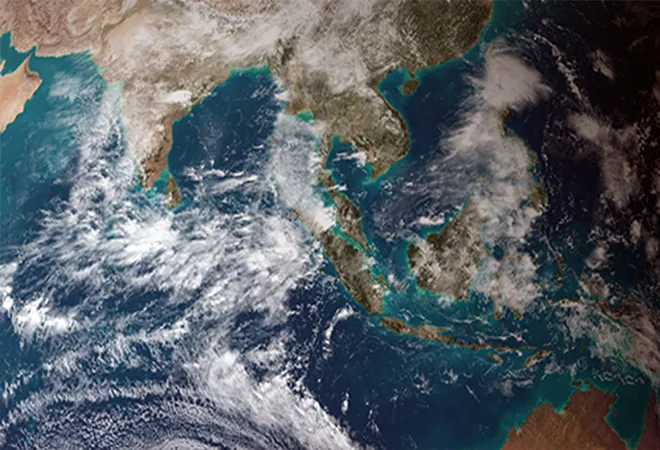
The Indo-Pacific has been key in shaping global politics in the current times and India is seen as a pivotal player in this region. This is the region where the great power competition between the United States (US) and China is the most prominent. Most countries like the US, Australia, Japan, South Korea, United Kingdom (UK), and the member countries of the European Union (EU) and Association of South East Asian Nations (ASEAN) have made the Indo-Pacific the primary facet of their foreign policies, and New Delhi assumes a central role in their respective policies.
The Indo-Pacific has been key in shaping global politics in the current times and India is seen as a pivotal player in this region.
India’s Indo-Pacific policy has been to strengthen partnerships with like-minded countries, and form issue-based coalitions to address a new strategic and security environment. This is clearly visible in how India’s engagement has been deepening with countries like the US, Japan, and Australia among others. India has been engaging with these countries in minilateral platforms like the Quad for instance, but India’s bilateral relationships with these countries have also grown exponentially in the past few years. The Indo-Pacific narrative and the importance that India enjoys within this geography, given its strategic location and its growing global profile, has led to India playing a bigger role in this region. While looking at how India’s Indo-Pacific policy is developing in the present times, India’s outreach in Southeast Asia and the South Pacific has been the most noteworthy. This article will look into the current policy initiatives taken by India to firm up its influence in Southeast Asia and the South Pacific and how it has contributed to India emerging as a credible and rising power in the Indo-Pacific region.
Southeast Asia
India is slowly evolving as a strategic player in Southeast Asia. India’s bilateral relations with most of the ASEAN member countries have been cordial. For a long time, India has been known mainly for its soft power credentials and its long cultural and civilisational links to this region. While these connections still hold ground, India is also turning out to be a trustable and dependable security and strategic partner in this region. India has
handed over missile corvette INS Kirpan to Vietnam, which is a 1,450-tonne Khukri-class missile corvette manned by 12 officers and 100 sailors, and was decommissioned from the Indian Navy after 32 years of service. During the visit of the Vietnamese Defence Minister, Phan Van Giang, to India last month, there were also
discussions of amping up training for Vietnamese military personnel operating submarines and fighter jets, as well as cooperation on cybersecurity and electronic warfare. There are speculations that a Brahmos deal might be quickly
inked with the Vietnamese side like the one sealed with the Philippines in January 2022. There are also talks of a potential trade deal being
signed in the near future between the two countries.
India has been known mainly for its soft power credentials and its long cultural and civilisational links to this region.
With the Philippines, too, after the
finalising of the US$374.96-million deal with the BrahMos Aerospace Private Limited in January 2022, the bilateral relationship has been on an upward trajectory. During the Secretary for Foreign Affairs of the Philippines (SFA) H.E. Mr. Enrique A. Manalo’s recent visit to India in June 2023, in the joint statement on the fifth India-Philippines Joint Commission on Bilateral Cooperation—released after the meeting with his Indian counterpart, External Affairs Minister, Dr. S. Jaishankar—India for the first time
recognised the legitimacy of the 2016 arbitration ruling by the Permanent Court of Arbitration in The Hague in favour of the Philippines’ sovereignty claims over China in the South China Sea. During this visit, a line of credit was also
offered to the Philippines for purchasing Indian defence equipment along with the prospect of
sending an Indian defence attaché to Manila soon and the
need for more engagements between the defence agencies of both the countries.
India, this year, also
co-hosted the inaugural ASEAN-India Maritime Exercise in the South China Sea in May 2023. India’s indigenously designed and built ships—destroyer INS Delhi and stealth frigate INS Satpura, maritime patrol aircraft P8I and integral helicopters—
exercised with naval ships from Brunei, Indonesia, Malaysia, the Philippines, Singapore, Thailand, and Vietnam. Additionally, India’s defence partnership with Indonesia has also been growing with an Indian Kilo-class conventional submarine
making a first-ever port call to Indonesia in February 2023.
South Pacific
India’s definition of the “Indo-Pacific” stretches from the Eastern coast of Africa to the islands of the South Pacific. The South Pacific or the Pacific Islands are increasingly becoming a theatre of great power competition with China’s growing influence in this region with the
signing of a security pact with the Solomon Islands, and the US trying to deter the Pacific Island nations from entering into security partnerships with Beijing. The US recently
concluded a defence agreement with Papua New Guinea (PNG). India has had a focus on the Pacific in the past as well, given the huge Indian diaspora in Fiji and through initiatives like the Forum for India-Pacific Islands Cooperation (FIPIC). But this year saw two high-level visits from India’s end. Prime Minister Modi
visited Fiji in May 2023 to meet his counterpart H.E. Mr. Sitiveni Ligamamada Rabuka, Prime Minister of the Republic of Fiji, on the sidelines of the third FIPIC Summit. Prime Minister Modi was
bestowed with the highest honour of the Republic of Fiji (the Companion of the Order of Fiji (CF)) during this visit on behalf of the Fijian President, H.E. Mr. Ratu Wiliame Maivalili Katonivere by Prime Minister Rabuka. In May 2023, PM Modi also
paid a visit to PNG, and, this month, two Indian frontline naval ships under the Eastern Naval Command—INS Sahyadri and INS Kolkata—
made port call at Port Moresby as part of ongoing initiatives for enhancing maritime partnership and cooperation with PNG. During PM Modi’s visit to Paris last month, India and France also
concluded an agreement for enhanced cooperation in the Pacific. The two sides agreed on a roadmap for the Indo-Pacific in which the need for more cooperative initiatives in the Pacific was stressed upon.
India’s defence partnership with Indonesia has also been growing with an Indian Kilo-class conventional submarine making a first-ever port call to Indonesia in February 2023.
Even after India started actively championing for a Free and Open Indo-Pacific, there were doubts about whether India will be able to focus much on the Eastern Indian Ocean and the Pacific, especially given that the Western Indian Ocean and South Asia form the main focal points in India’s foreign and security policies. But, with time, India has been paying greater attention to its eastern flank and is emerging as a notable strategic player in the Indo-Pacific region.
Premesha Saha is a Fellow with the Strategic Studies Programme at the Observer Research Foundation.
The views expressed above belong to the author(s). ORF research and analyses now available on Telegram! Click here to access our curated content — blogs, longforms and interviews.



 The Indo-Pacific has been key in shaping global politics in the current times and India is seen as a pivotal player in this region. This is the region where the great power competition between the United States (US) and China is the most prominent. Most countries like the US, Australia, Japan, South Korea, United Kingdom (UK), and the member countries of the European Union (EU) and Association of South East Asian Nations (ASEAN) have made the Indo-Pacific the primary facet of their foreign policies, and New Delhi assumes a central role in their respective policies.
The Indo-Pacific has been key in shaping global politics in the current times and India is seen as a pivotal player in this region. This is the region where the great power competition between the United States (US) and China is the most prominent. Most countries like the US, Australia, Japan, South Korea, United Kingdom (UK), and the member countries of the European Union (EU) and Association of South East Asian Nations (ASEAN) have made the Indo-Pacific the primary facet of their foreign policies, and New Delhi assumes a central role in their respective policies.
 PREV
PREV


